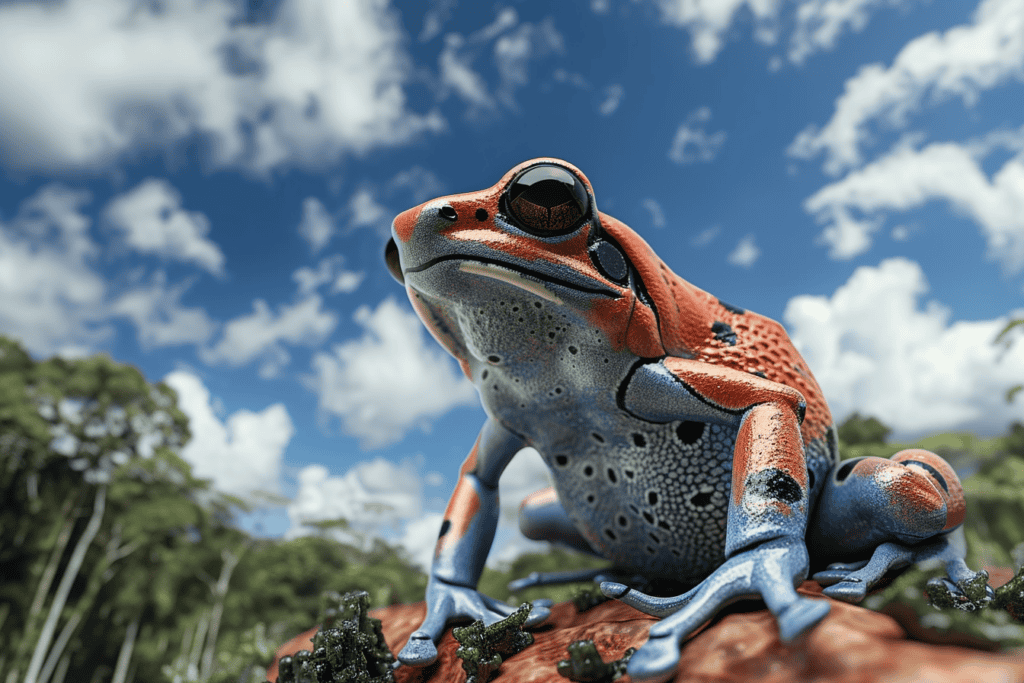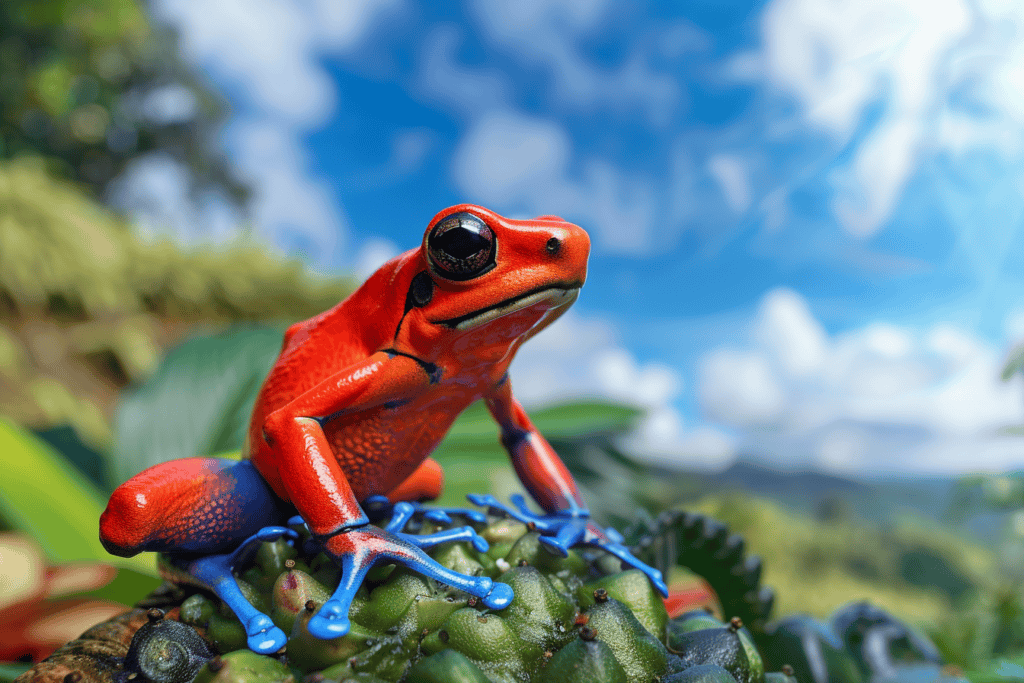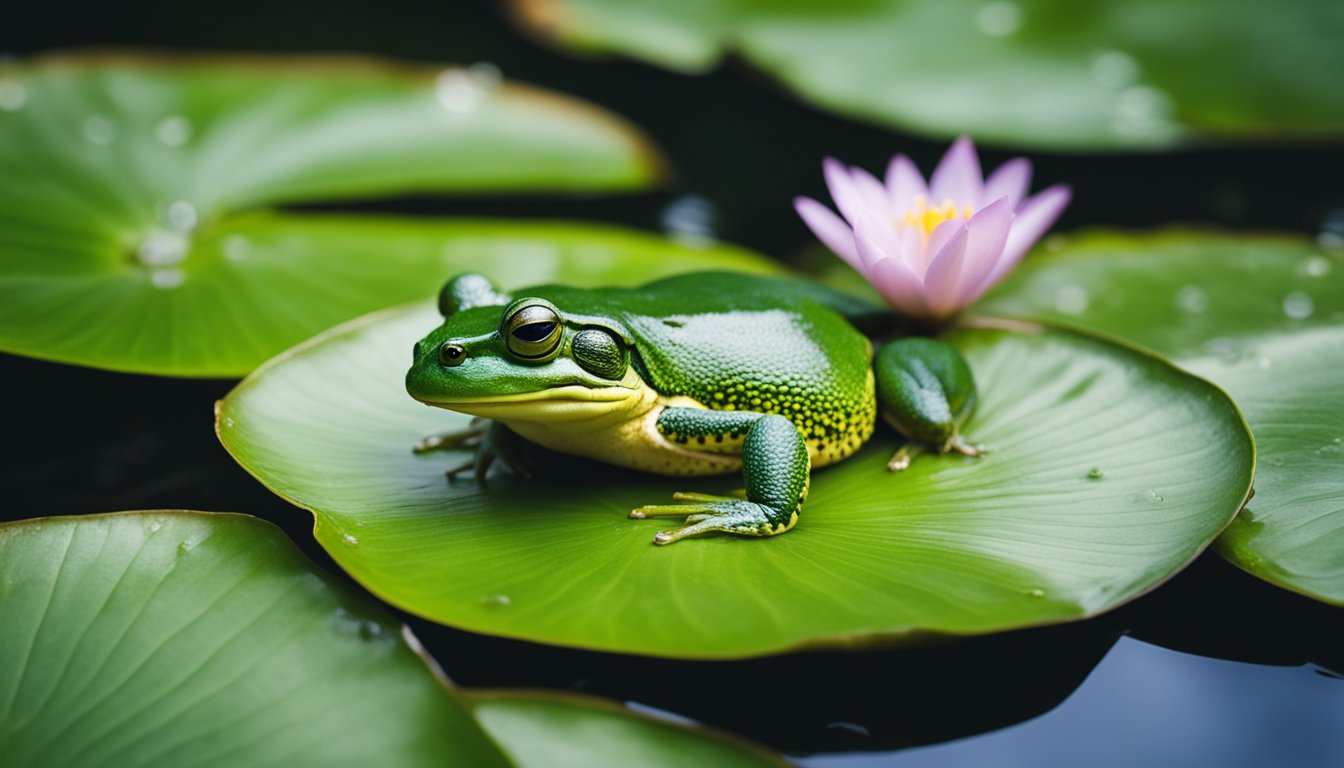Poison dart frogs are among the most colorful and fascinating creatures on the planet. These small amphibians are native to the rainforests of Central and South America.
Here, they have evolved some of the most vibrant and striking colors in the animal kingdom. But don’t let their beauty fool you – these frogs are also some of the most toxic creatures on Earth.

Despite their small size, poison dart frogs are incredibly deadly. The toxins they produce can cause paralysis, convulsions, and even death in some cases.
Interestingly, the bright colors of these frogs serve as a warning to predators that they are not to be messed with. In fact, some indigenous tribes in South America have been known to use the toxins from these frogs to coat the tips of their blow darts and arrows for hunting purposes.
The Vivid World of Poison Dart Frogs
Poison dart frogs are a group of brightly colored amphibians belonging to the family Dendrobatidae.
These fascinating creatures are known for their vibrant hues, which range from bright reds and yellows to striking blues and greens.
But their beauty is not just skin deep; they are also some of the most toxic animals on the planet.
There are over 170 species of poison dart frogs, each with its unique coloration and toxicity level.
The golden poison frog, for example, is one of the most toxic species in the world, with enough poison to kill ten grown men. It has a bright yellow coloration, which acts as a warning to predators to stay away.
On the other hand, the strawberry poison dart frog has a bright red coloration with blue legs, while the blue poison dart frog has a striking blue coloration with black spots. These colors are not just for show; they serve as a defense mechanism against predators.
Poison dart frogs come in a range of sizes, with some species measuring less than an inch long.
The black-legged poison dart frog, for example, is only about half an inch long, while the dendrobates tinctorius can grow up to two inches long.
Despite their small size, poison dart frogs are mighty predators. They feed on insects such as ants, termites, and beetles, which they catch with their long, sticky tongues.
The Secret Behind Their Striking Colors

Poison dart frogs are known for their striking and vibrant colors, which make them stand out in the rainforest. But why are these tiny creatures so colorful? The answer lies in a phenomenon called aposematism.
Aposematism is a type of warning coloration that signals to predators that the animal is toxic or dangerous.
Poison dart frogs are some of the most toxic animals on the planet, and their bright colors serve as a warning to predators not to mess with them.
In fact, the brighter the color, the more toxic the frog is likely to be. The red frogs, for example, are some of the most poisonous of all the poison dart frogs. Their bright color is a warning signal to predators that they should stay away or risk getting seriously ill.
Camouflage and Predators: A Delicate Balance
While aposematism is one way that poison dart frogs protect themselves, it’s not the only way.
Some species have evolved to blend in with their surroundings, using camouflage to avoid detection by predators.
This is a delicate balance, however, as some predators have evolved to be able to spot even the most cryptic of frogs. Mimic poison frogs, for example, have evolved to look like other, less toxic frog species in order to avoid being eaten.
The Lethal Arsenal: Understanding Frog Toxicity

Poison dart frogs are fascinating creatures that have been known to be highly toxic. These small, brightly colored amphibians are native to the rainforests of Central and South America.
They have been known to be extremely dangerous due to the toxins they produce. In this section, we will explore the sources of their toxicity and the potency of their poison.
Poison dart frogs produce toxins that are derived from their diet. These toxins are obtained from the insects and other small animals that they eat, such as ants, termites, and beetles.
The toxins are then stored in the skin of the frog, making them lethal to predators.
One of the most toxic species of poison dart frog is the Phyllobates terribilis, which produces a toxin known as batrachotoxin.
This toxin is so deadly that a single frog can produce enough poison to kill ten adult humans. The frogs obtain this toxin from the beetles they eat, which contain the toxin in their bodies.
The Potency of Poison: Species-Specific Toxins
Different species of poison dart frogs produce different types of toxins, and the potency of the poison varies greatly between species.
The golden poison dart frog, for example, is one of the most toxic species, producing a toxin that is 20 times more lethal than that of the Phyllobates terribilis.
The toxins produced by poison dart frogs are highly toxic and can cause paralysis, convulsions, and even death. However, these toxins have also been found to have medicinal properties.
Scientists are studying the toxins produced by these frogs to develop new drugs to treat pain and other medical conditions.
Living with Poison Dart Frogs: Conservation and Captivity

Poison dart frogs are fascinating creatures that play an important role in the natural world. Unfortunately, they face many challenges in the wild due to habitat loss and pollution.
Logging, agriculture, and urbanization are some of the major threats to their natural environment. Deforestation and habitat fragmentation disrupt the delicate balance of ecosystems, making it difficult for these amphibians to survive.
As a result, many species of poison dart frogs are endangered, with some on the brink of extinction.
Conservation efforts are underway to protect their habitats and prevent further decline in their populations. This includes protecting their natural habitats, reducing pollution, and regulating the pet trade.
Life in a Controlled Environment
In captivity, poison dart frogs are popular pets due to their vibrant colors and unique patterns. However, it is important to remember that these frogs are not domesticated animals and require specialized care.
Captive breeding programs have helped reduce the demand for wild-caught frogs, which can be harmful to both the environment and the frog populations.
Tadpoles and eggs require specific conditions to develop properly, including temperature and humidity control. Once they mature, adult frogs need a terrarium with a suitable substrate, plants, and hiding places.
It is important to provide a balanced diet and avoid overfeeding, as obesity can lead to health problems.
Frequently Asked Questions

How can you identify a poison dart frog?
Poison dart frogs are small, brightly colored amphibians found in Central and South America. They come in a variety of colors, including bright red, yellow, blue, green, and orange.
These vibrant colors serve as a warning to predators that they are toxic and should not be eaten. Poison dart frogs also have a distinctive body shape, with smooth skin and short legs.
What makes poison dart frogs so toxic?
The toxicity of poison dart frogs comes from the alkaloids in their skin. Alkaloids are a type of chemical compound that can be highly toxic to predators.
Scientists believe that poison dart frogs obtain these alkaloids by eating certain insects, such as ants and beetles, which also produce the compounds. The frogs are able to store the alkaloids in their skin, making them toxic to predators.
Can touching a poison dart frog be harmful to humans?
Yes, touching a poison dart frog can be harmful to humans. While the toxicity of different species of poison dart frogs varies, many are highly toxic and can cause serious harm or even death to humans.
It is important to never touch or handle a poison dart frog, especially in the wild.
Which poison dart frog is considered the most dangerous?
The golden poison dart frog is considered the most dangerous species of poison dart frog. It is also one of the most toxic animals in the world.
The skin of a single golden poison dart frog contains enough toxin to kill up to 20,000 mice or 10 humans.
How does the coloration of poison dart frogs relate to their toxicity?
The coloration of poison dart frogs is thought to be related to their toxicity. The brighter and more vibrant the color, the more toxic the frog is likely to be.
This is because the color serves as a warning to predators that the frog is toxic and should not be eaten.
What should you do if you encounter a poison dart frog in the wild?
If you encounter a poison dart frog in the wild, it is important to avoid touching or handling the frog. Poison dart frogs are highly toxic and can cause serious harm or even death to humans.
Instead, observe the frog from a safe distance and appreciate its beauty from afar.




